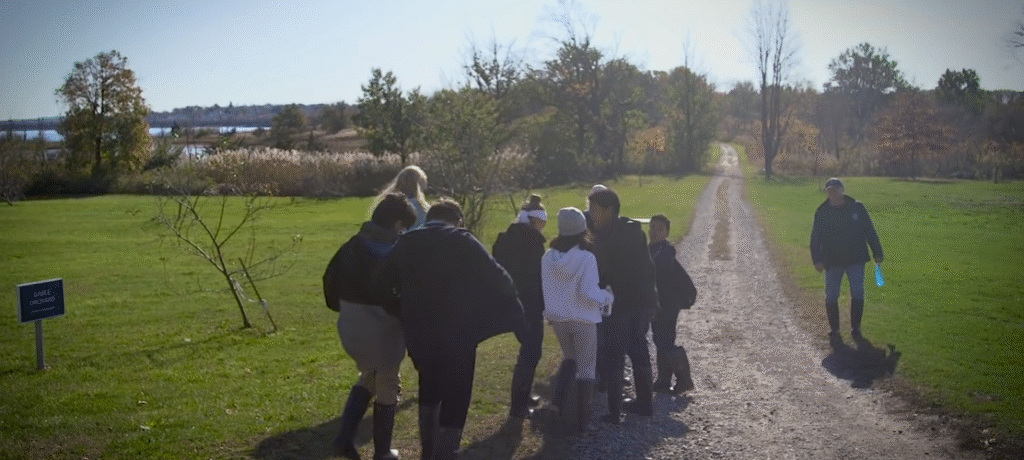The increasing popularity of outdoor education is a subtle but noteworthy development in contemporary education. After years of research, educators like Dr. Lisa Frances have shown how moving outside of the traditional classroom leads to healthier, more motivated teachers and more involved students. The movement’s strength is not radical reform but rather its organic simplicity; learning outside while taking in the soft rhythm of nature is redefining what it means to receive an effective education.
Outdoor classrooms, which combine movement, conversation, and curiosity, are remarkably similar to therapy sessions, according to educators. Both physically and emotionally, the mood is lighter. According to Dr. Frances’ 2025 study, outdoor instruction greatly improved student focus and engagement while lowering teacher stress levels. Teachers expressed feeling “happier, calmer, and more fulfilled,” a result that has been elusive for decades in traditional education.
Both professional and personal well-being have benefited greatly from this strategy. Teachers discovered that being outside boosted their physical activity, enhanced their mental well-being, and reignited their passion for teaching. One participant summed up the intense emotional relief of leaving cramped areas by calling the experience “a chance to breathe again.” For a lot of teachers, outdoor learning was more than just a teaching strategy; it was a way to rediscover happiness and meaning.
Profile Information
| Name | Dr. Lisa Frances |
|---|---|
| Occupation | Educator, Researcher, Outdoor Learning Advocate |
| Affiliation | University of New England, Australia |
| Education | Ph.D. in Education, University of New England |
| Research Focus | Integration of outdoor learning in early education; teacher well-being and pedagogical innovation |
| Publications | “It Makes Me a Better Teacher: The Benefits of Outdoor Learning for Teachers” (Journal of Adventure Education & Outdoor Learning, 2025) |
| Notable Contributions | Led multi-school studies proving that outdoor learning enhances teacher satisfaction and student engagement |
| Reference | Taylor & Francis Online – Journal of Adventure Education and Outdoor Learning |

Additionally, outdoor learning promotes connection, which is something that is sometimes disregarded in strict classroom environments. Instructors noticed that students spoke more openly outside and frequently shared concepts that were kept confidential inside. Children “open up when the sky is their ceiling,” according to one educator, implying that emotional barriers fall away just as easily as physical ones. The transition from organized workstations to open spaces encourages empathy and teamwork, resulting in connections that are incredibly powerful in fostering confidence and trust.
The actual surroundings are very important. Noise in the classroom can be deafening, reverberating off walls, increasing stress, and wearing people down. Sound spreads naturally outside. In a humorous way, one educator likened the distinction to “moving from loud rock music to something calming.” The shift is profoundly psychological as well as auditory. Reduced stress results in improved morale, improved communication, and clearer thinking. Teachers’ ability to remain composed and focused has significantly improved as a result of the decrease in sensory overload, creating an extremely effective learning environment.
Students also exhibit transformative reactions. Children in nature-based programs exhibit greater emotional resilience and self-regulation than children in traditional classrooms, according to research from the National Institutes of Health. The explanation is very obvious: outdoor settings foster independence, inquisitiveness, and realistic problem-solving. Learning becomes tactile, intuitive, and self-driven when students investigate patterns in leaves or compute shadows to learn geometry. In ways that static lessons rarely do, these experiences mold initiative and confidence.
Teachers have direct experience with the ripple effect. In Dr. Frances’ study, one participant reported that a student who had trouble indoors became “amazing outside.” Through movement and interaction with the surroundings, the boy, who had previously been restless and distracted, was able to focus. Stories like these are not unique. Similar findings are being reported in Scandinavia, Canada, and Australia: classrooms without walls are producing kids who naturally collaborate, think creatively, and listen better. These apparent increases in student engagement are gratifying and revitalizing for educators.
Prominent figures in public life have also taken notice of this changing trend in education. Emma Watson, an environmentalist, has commended nature-based programs for helping kids develop their creativity and empathy. In an effort to encourage communities to re-establish a connection between education and the natural world, Prince William’s Earthshot initiative has provided funding for educational initiatives that integrate sustainability and outdoor exploration. Leaders in the tech industry, such as Jeff Bezos and Larry Page, who received their education in Montessori and nature-based systems, credit their early exposure to self-directed, curiosity-driven environments for their creative thinking.
It is impossible to overestimate the emotional impact of teaching outside. It is referred to by many educators as “feeling human again.” In its simplicity, nature’s ability to balance freedom and responsibility is especially inventive. Students learn via respect for one another and collaborative inquiry rather than strict discipline. As they walk alongside their students—sometimes literally—through lessons that combine academic and emotional intelligence, teachers transform from overseers to guides. This strategy is in line with contemporary leadership theories that substitute empathy and teamwork for authority and control.
Additionally, teacher burnout, a problem impacting education worldwide, can be effectively addressed by outdoor learning. Physical activity, sunshine, and fresh air all work together to improve mood, lessen anxiety, and improve sleep quality. Teachers now refer to themselves as “reignited” after feeling imprisoned by institutional pressure. Schools have reported increased job satisfaction and decreased absenteeism when incorporating outdoor sessions, even once a week. The findings demonstrate that students flourish when teachers are mentally healthy, a mutually reinforcing dynamic.
